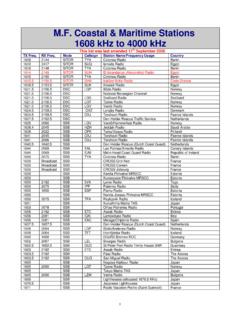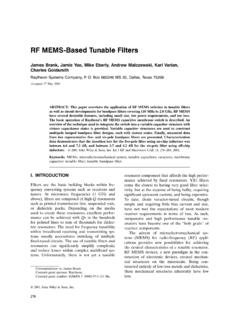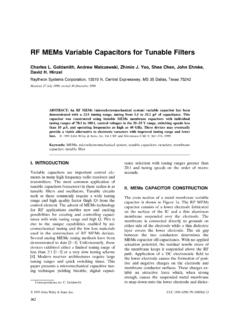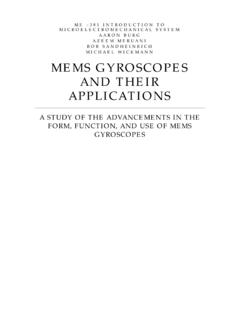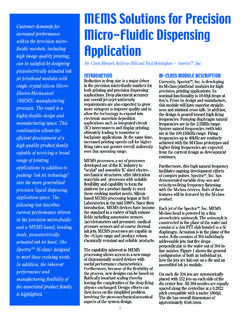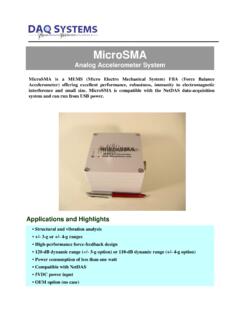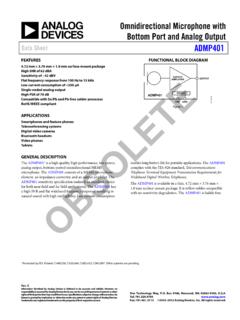Transcription of RF MEMS Circuit Design for Wireless Communications
1 RF mems Circuit Design for Wireless Communications For a listing of recent titles in the Artech House Microelectromechanical Systems ( mems ) Series, turn to the back of this book. RF mems Circuit Design for Wireless Communications H ctor J. De Los Santos Artech House Boston London Library of Congress Cataloging-in-Publication Data De Los Santos, H ctor J. RF mems Circuit Design for Wireless Communications /H ctor J. De Los Santos. p. cm. (Artech House microelectromechanical systems library). Includes bibliographical references and index. ISBN 1-58053-329-9 (alk. paper). 1. Wireless communication systems Equipment and supplies. 2. Radio circuits. 3. Microelectromechanical systems. I. Title. II. Series. 2002. dc21 2002016428. British Library Cataloguing in Publication Data De Los Santos, H ctor J. RF mems Circuit Design for Wireless Communications .
2 (Artech House microelectromechanical systems series). 1. Electronic Circuit Design . 2. Radio frequency. 3. Microelectromechanical systems. I. Title 815. ISBN 1-58053-329-9. Cover Design by Igor Valdman 2002 H ctor J. De Los Santos All rights reserved. Printed and bound in the United States of America. No part of this book may be reproduced or utilized in any form or by any means, electronic or mechanical, in- cluding photocopying, recording, or by any information storage and retrieval system, with- out permission in writing from the publisher. All terms mentioned in this book that are known to be trademarks or service marks have been appropriately capitalized. Artech House cannot attest to the accuracy of this informa- tion. Use of a term in this book should not be regarded as affecting the validity of any trade- mark or service mark. International Standard Book Number: 1-58053-329-9.
3 Library of Congress Catalog Card Number: 2002016428. 10 9 8 7 6 5 4 3 2 1. Este libro lo dedico a mis queridos padres y a mis queridos, Violeta, Mara, Hectorcito, y Joseph. Y sabemos que a los que aman a Dios todos los cosas las ayudan a bien, esto es, a los que conforme a su prop sito son llamados. Romanos 8:28.. Contents Preface xiii Acknowledgments xvii 1 Wireless Systems A Circuits Perspective 1. Introduction 1. Spheres of Wireless Activity Technical Issues 3. The Home and the Office 5. The Ground Fixed/Mobile Platform 7. The Space Platform 7. Wireless Standards, Systems, and Architectures 8. Wireless Standards 8. Conceptual Wireless Systems 8. Wireless Transceiver Architectures 10. Power- and Bandwidth-Efficient Wireless Systems . Challenges 12. vii viii RF mems Circuit Design for Wireless Communications mems -Based Wireless Appliances Enable Ubiquitous Connectivity 15.
4 Summary 16. References 17. 2 Elements of RF Circuit Design 19. Introduction 19. Physical Aspects of RF Circuit Design 19. Skin Effect 20. Transmission Lines on Thin Substrates 23. Self-Resonance Frequency 33. Quality Factor 35. Moding (Packaging) 39. Practical Aspects of RF Circuit Design 40. dc Biasing 40. Impedance Mismatch Effects in RF mems 41. Problems 43. Summary 47. References 48. 3 RF mems Enabled Circuit Elements and Models 51. Introduction 51. RF/Microwave Substrate Properties 52. Micromachined-Enhanced Elements 55. Capacitors 55. Inductors 57. Varactors 67. MEM Switches 75. Shunt MEM Switch 75. Low-Voltage Hinged MEM Switch Approaches 78. Contents ix Push-Pull Series Switch 80. Folded-Beam-Springs Suspension Series Switch 83. Resonators 87. Transmission Line Planar Resonators 87. Cavity Resonators 87. Micromechanical Resonators 88.
5 Film Bulk Acoustic Wave Resonators 98. mems Modeling 104. mems Mechanical Modeling 105. mems Electromagnetic Modeling 106. Summary 109. References 109. 4 Novel RF mems Enabled Circuits 115. Introduction 115. Reconfigurable Circuit Elements 116. The Resonant mems Switch 116. Capacitors 118. Inductors 121. Tunable CPW Resonator 123. mems Microswitch Arrays 124. Reconfigurable Circuits 126. Double-Stub Tuner 127. Nth-Stub Tuner 130. Filters 132. Resonator Tuning System 133. Massively Parallel Switchable RF Front Ends 136. True Time-Delay Digital Phase Shifters 137. Reconfigurable Antennas 139. Tunable Dipole Antennas 139. Tunable Microstrip Patch-Array Antennas 140. x RF mems Circuit Design for Wireless Communications Summary 141. References 142. 5 RF mems Based Circuit Design Case Studies 145. Introduction 145. Phase Shifters 146. Phase Shifter Fundamentals 146.
6 X-Band RF mems Phase Shifter for Phased Array Applications Case Study 151. Ka-Band RF mems Phase Shifter for Phased Array Applications Case Study 155. Ka-Band RF mems Phase Shifter for Radar Systems Applications Case Study 159. Film Bulk Acoustic Wave Filters 163. FBAR Filter Fundamentals 163. FBAR Filter for PCS Applications Case Study 165. RF mems Filters 167. A Ka-Band Millimeter-Wave Micromachined Tunable Filter Case Study 167. A High-Q 8-MHz MEM Resonator Filter Case Study 171. RF mems Oscillators 183. RF mems Oscillator Fundamentals 184. A 14-MHz MEM Oscillator Case Study 187. A Ka-Band Micromachined Cavity Oscillator Case Study 191. A mems -Based Voltage-Controlled Oscillator Case Study 194. Summary 201. References 201. Contents xi Appendix A: GSM Radio Transmission and Reception Specifications 205. Output Power 206. Mobile Station 206.
7 Base Station 211. Output RF Spectrum 213. Spectrum Due to Modulation and Wideband Noise 214. Spectrum Due to Switching Transients 221. Spurious Emissions 222. Principle of the Specification 223. Base Transceiver Station 224. Mobile Station 227. Radio Frequency Tolerance 229. Output Level Dynamic Operation 229. Base Transceiver Station 230. Mobile Station 230. Modulation Accuracy 231. GMSK Modulation 231. 8-PSK Modulation 231. Intermodulation Attenuation 233. Base Transceiver Station 234. Intra BTS Intermodulation Attenuation 234. Intermodulation Between MS (DCS 1800 &. PCS 1900 Only) 235. Mobile PBX (GSM 900 Only) 235. Receiver Characteristics 236. Blocking Characteristics 236. AM Suppression Characteristics 241. xii RF mems Circuit Design for Wireless Communications Intermodulation Characteristics 242. Spurious Emissions 243. List of Acronyms 245.
8 About the Author 249. Index 251. Preface This book examines the recent progress made in the emerging field of microelectromechanical systems ( mems ) technology in the context of its imminent insertion and deployment in radio frequency (RF) and microwave Wireless applications. In particular, as the potential of RF mems to enable the implementation of sophisticated, yet low-power, portable appliances that will fuel the upcoming Wireless revolution gains wide recognition, it is imperative that the knowledge base required to quickly adopt and gainfully exploit this technology be readily available. In addition, the material pre- sented herein will aid researchers in mapping out the terrain and identifying new research directions in RF mems . Accordingly, this book goes beyond an introduction to mems for RF and microwaves [which was the theme of our previous book Introduction to Microelectromechanical (MEM) Microwave Systems (Artech House, 1999)] and provides a thorough examination of RF.
9 mems devices, models, and circuits that are amenable for exploitation in RF/microwave Wireless Circuit Design . This book, which assumes basic, preparation in physics or electrical engineering, is intended for senior undergraduate or beginning graduate students, practicing RF and microwave engineers, and mems . device researchers who are already familiar with the fundamentals of both RF. mems and traditional RF and microwave Circuit Design . Chapter 1 of RF mems Circuit Design for Wireless Communications starts by clearly stating the ubiquitous Wireless Communications problem, in particular, as it relates to the technical challenges in meeting the extreme xiii xiv RF mems Circuit Design for Wireless Communications levels of appliance functionality (in the context of low power consumption). demanded by consumers in their quest for connectivity at home, while on the move, or on a global basis.
10 The chapter continues with a review of the Wireless standards, systems, and traditional architectures, as well as their limi- tations, which, in turn, are imposed by those of the conventional RF tech- nologies they utilize. Finally, it posits the real prospect of RF mems as the technology that can overcome these limitations and thus enable the ubiqui- tous connectivity paradigm. Chapter 2 provides a review of those salient points in the discipline of RF Circuit Design that are key to its successful practice and are intimately related to the successful exploitation of RF mems devices in circuits. In par- ticular, the subjects of skin effect, the performance of transmission lines on thin substrates, self-resonance frequency, quality factor, moding (packaging), DC biasing, and impedance mismatch are discussed. Chapter 3 provides an in-depth examination of the arsenal of mems - based devices on which RF mems Circuit Design will be predi- cated namely, capacitors, inductors, varactors, switches, and resonators, including pertinent information on their operation, models, and fabrication.




